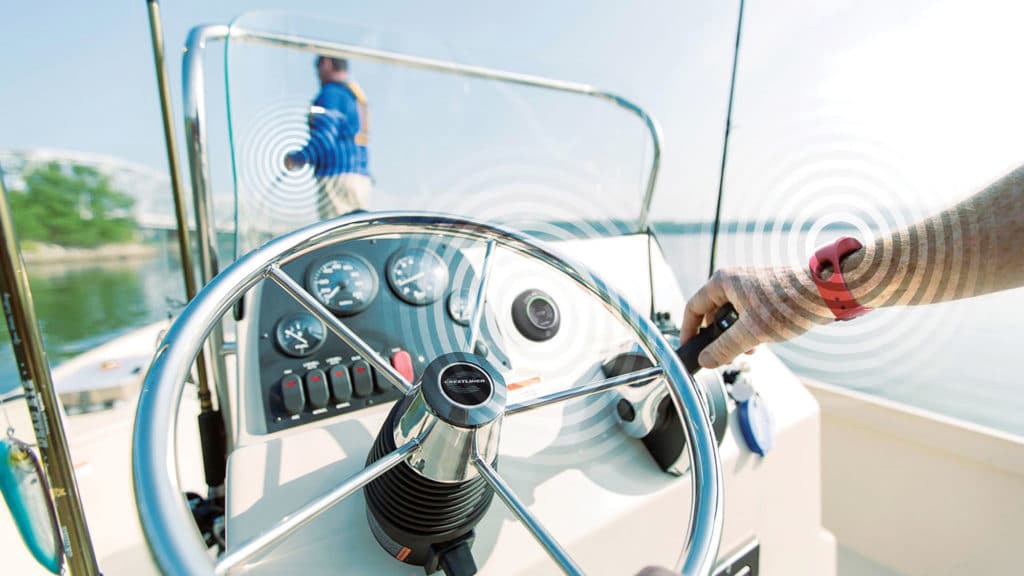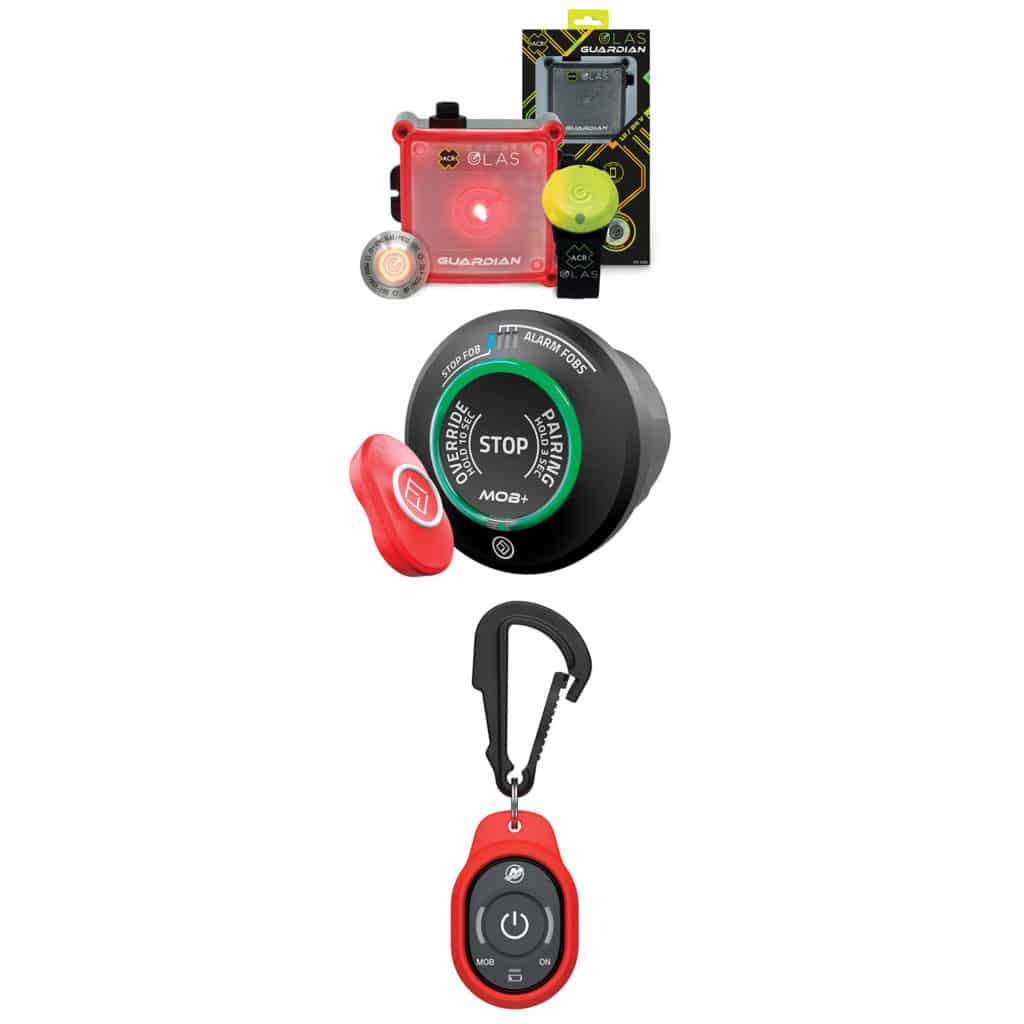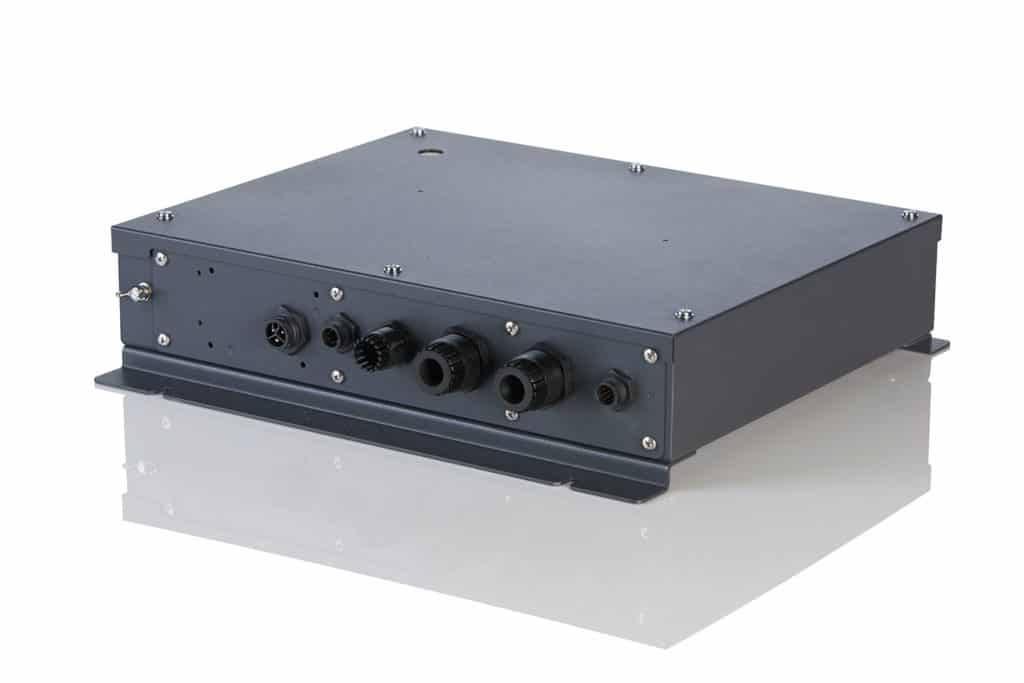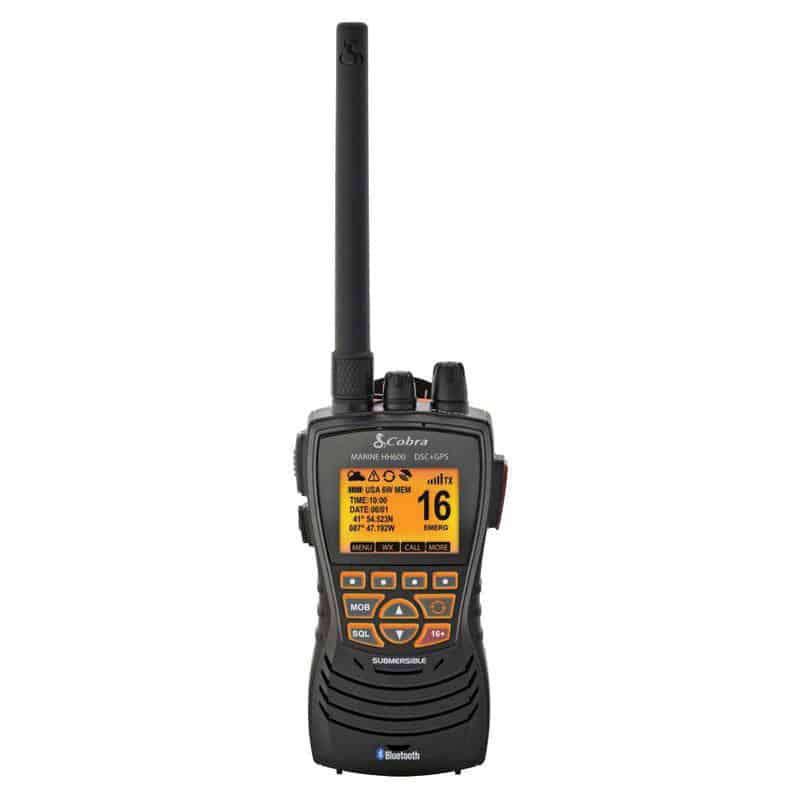
Nearly all boats today feature safety-stop lanyards to shut down the engine(s) if the helmsman is tossed overboard. This helps ensure safety when traveling at high speed, boating solo, or fishing with guests who are unfamiliar with operating a boat. Lanyards, however, stretch to only about 5 feet, so they limit the skipper’s mobility considerably. But wireless kill switches now give the skipper the ability to leave the helm with the assurance the motor will stop if he falls overboard. All of these systems rely on small devices worn on the person and connected wirelessly with an onboard module. Here are the systems currently available.
ACR Guardian
The new Guardian, part of ACR’s OLAS (Overboard Location Alert System) series, stops boat engines within two seconds of a person going overboard. In addition, it triggers a loud alarm. After five seconds, the engine can be restarted.
The Guardian connects via Bluetooth with compact transmitters known as the Tag and Float-On. A break in the Bluetooth connection serves as the trigger.
The Guardian module is powered by a vessel’s 12- or 24-volt DC supply. It ties in to the existing kill switch and allows the continued use of a conventional safety-stop lanyard. Automatically connecting to an OLAS transmitting device within a 2-meter range, The Guardian features a pause mode that allows the skipper to leave the boat with the engine idling.

The system can connect with up to 15 crewmembers via the ACR OLAS mobile app, which provides an easy-to-read directional MOB screen showing where the alarm was triggered and advising on the correct mayday call. The app also allows the captain to select which transmitters will trigger engine cutoff, and which will set off alarms only. Pricing starts at $249.95.
Autotether
Autotether uses a relatively low-tech approach that simplifies installation and eliminates the need to splice into your boat’s electrical circuitry.
A host module attaches near the existing kill switch with a hook-and-loop (aka Velcro) fastener. A coiled lanyard extends from the module with a clip on the end that attaches to the existing kill switch, replacing the conventional lanyard. A loop on the clip lets you attach a conventional lanyard as well.
A remote sensor pairs with the host module and is worn by the helmsman. If the boat operator goes overboard, the sensor triggers the electromechanical device on the end of the lanyard to disconnect from the boat’s kill switch and shut down propulsion. If linked to the Autotether Screamer horn, it also sounds an alarm.
The system can be used on multiple boats. The kit includes clips for any brand or type of engine kill switch. You can also purchase additional wireless sensors for passengers to wear.
Components are powered by AAA batteries, and a test button on the host module tells you if the batteries for the module and sensor are good or need replacing. The system starts at $235, with additional sensors priced at $95.
Fell Marine
The MOB+ system from Fell Marine includes an xHub (powered by onboard 12-volt DC) that installs in a standard 2-inch instrument hole. It is designed to be hard-wired into the existing kill switch of virtually any engine brand, and it can be connected in a manner that maintains functionality of the conventional safety-stop lanyard.
Fell’s xHub pairs wirelessly at the press of button with its xFob devices. A green light and audio tone confirm the connection. The xFob is powered by a CR2032 disposable battery, and can be worn around the neck with a lanyard, placed inside a wristband, or attached to clothing or a life jacket.
If an xFob wearer goes in the water, the engine shuts down within one second. The xHub pairs with up to three additional xFobs at the same time. So, it serves as a general-purpose MOB safety system as well as a wireless kill switch. The system enables engine restarting in six seconds.
The Fell Marine MOB+ base pack, which includes the xHub and one xFob, sells for $199.99. Additional xFobs are priced at $39.99.
Mercury Marine
The 1st Mate wireless overboard alert system from Mercury Marine uses wearable fobs that pair wirelessly with a free mobile app, which, in turn, communicates with an engine-integrated hub. The system covers up to eight crewmembers, including the captain.
If the captain (identified by a special fob) goes overboard, the engine(s) immediately stops, and an audible alarm sounds from the hub and any nearby mobile device with the app. If the captain is out fishing by himself, the system can also send messages to contacts in the emergency list. If a passenger falls over the side, audible alarms sound, but the motor continues to run. In both cases, the app records the GPS location at the time of the alert.
The Merc system also acts as a theft deterrent by locking the engines, which will not be fully functional, even if removed from the vessel, without a security handshake from the hub. It is designed to work with all SmartCraft-compatible Mercury engines, including outboards, sterndrive systems and inboards.
The 1st Mate system is also available under Merc’s aftermarket label, Quicksilver, which works with non-SmartCraft Mercury motors and marine engines from other brands, but it lacks some of the functionality of the Merc system, including the theft deterrent.
The 1st Mate system starts at $571.41 for a single engine, with the cost increasing with the number of engines.
Thanks to the new breed of wireless kill switches, captains can now leave the helm and join in on the fishing action with greater peace of mind and safety.
New Electronics

Furuno’s Deep Impact DI-FFAMP amplifier networks with the built-in, dual-channel TruEcho CHIRP fish finder in NavNet TZtouch3 multifunction displays. It boosts power of the standard 1 kW fish finder by 300 percent to view fish and bottom structure more clearly and at greater depths. It can also be configured as a high-power traditional continuous wave (CW) fish finder to work with high-power CW transducers. It powers 5 kW and 10 kW transducers to reach depths of 10,000 feet. $1,795; furunousa.com

The MR HH600 floating IPX8 waterproof-rated handheld VHF radio from Cobra Marine has built-in GPS and DSC (digital selective calling), including a DSC distress button and flashlight that blinks an SOS. The 6-watt radio includes Bluetooth connectivity with a smartphone that allows you to make and receive cell calls with the radio. The Say-Again function replays missed VHF calls. It includes a rechargeable li-ion battery and chargers, a AA battery tray, belt clip and wrist strap. $209.95; cobra.com

Fusion, the marine audio arm of Garmin, has debuted the Signature Series 3 boat speakers with LED lighting that deliver a wide spectrum of -color to match the music and mood. You control the color with the optional CRGBW wireless remote control or Garmin MFD. The speakers are available in 6.5-, 7.7- and 8.8-inch sizes, as well as a new 12-inch subwoofer with 1,600 watts of peak power. $399.99 to $549.99 for speakers, $349.99 to $749.99 for subwoofers; fusionentertainment.com









